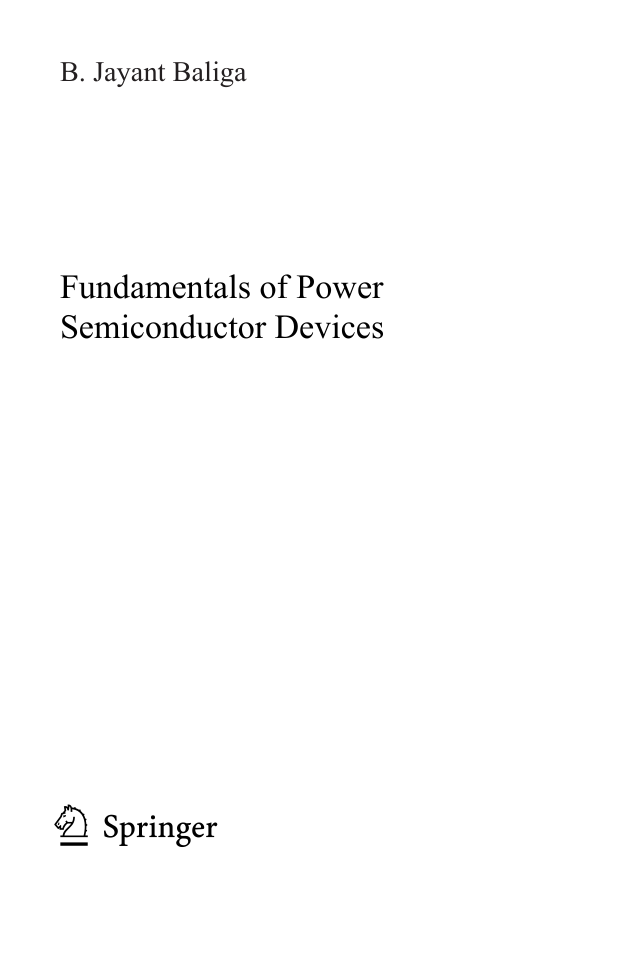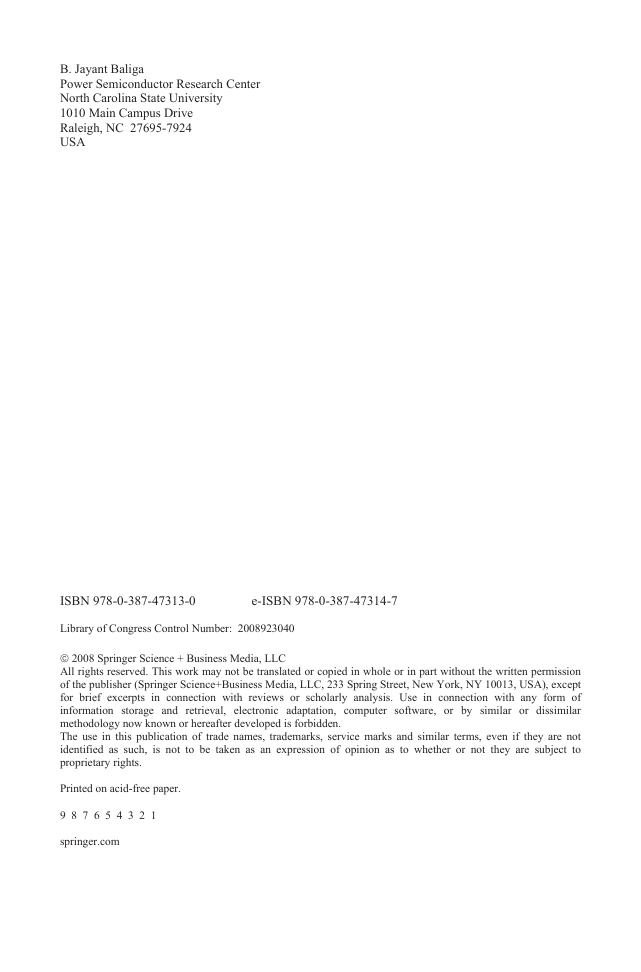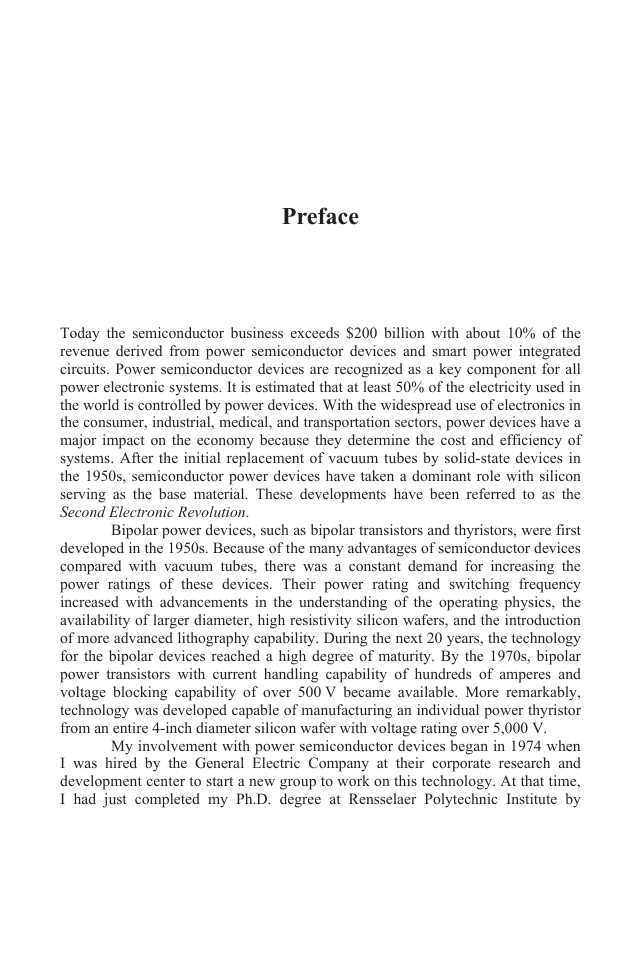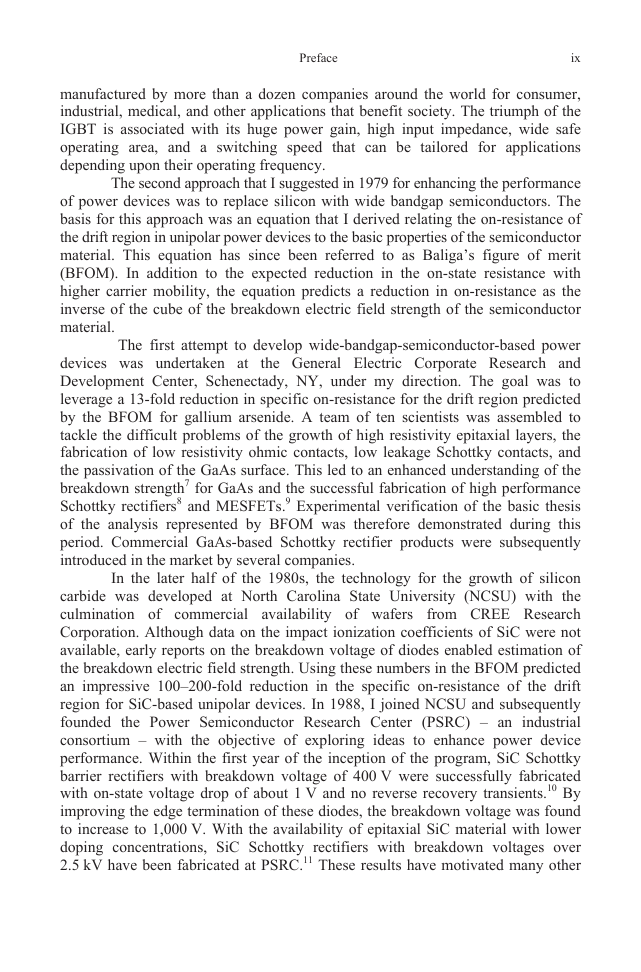�
Fundamentals of Power
Semiconductor Devices
B. Jayant Baliga
Fundamentals of Power
Semiconductor Devices
1 3
�
B. Jayant Baliga
Power Semiconductor Research Center
North Carolina State University
1010 Main Campus Drive
Raleigh, NC 27695-7924
USA
e-ISBN 978-0-387-47314-7
ISBN 978-0-387-47313-0
Library of Congress Control Number: 2008923040
© 2008 Springer Science + Business Media, LLC
All rights reserved. This work may not be translated or copied in whole or in part without the written permission
of the publisher (Springer Science+Business Media, LLC, 233 Spring Street, New York, NY 10013, USA), except
for brief excerpts in connection with reviews or scholarly analysis. Use in connection with any form of
information storage and retrieval, electronic adaptation, computer software, or by similar or dissimilar
methodology now known or hereafter developed is forbidden.
The use in this publication of trade names, trademarks, service marks and similar terms, even if they are not
identified as such, is not to be taken as an expression of opinion as to whether or not they are subject to
proprietary rights.
Printed on acid-free paper.
9 8 7 6 5 4 3 2 1
springer.com
�
Dedication
The author would like to dedicate this book to his wife, Pratima, for her unwavering
support throughout his career devoted to the enhancement of the performance and
understanding of power semiconductor devices.
v
�
Preface
Today the semiconductor business exceeds $200 billion with about 10% of the
revenue derived from power semiconductor devices and smart power integrated
circuits. Power semiconductor devices are recognized as a key component for all
power electronic systems. It is estimated that at least 50% of the electricity used in
the world is controlled by power devices. With the widespread use of electronics in
the consumer, industrial, medical, and transportation sectors, power devices have a
major impact on the economy because they determine the cost and efficiency of
systems. After the initial replacement of vacuum tubes by solid-state devices in
the 1950s, semiconductor power devices have taken a dominant role with silicon
serving as the base material. These developments have been referred to as the
Second Electronic Revolution.
Bipolar power devices, such as bipolar transistors and thyristors, were first
developed in the 1950s. Because of the many advantages of semiconductor devices
compared with vacuum tubes, there was a constant demand for increasing the
power ratings of these devices. Their power rating and switching frequency
increased with advancements in the understanding of the operating physics, the
availability of larger diameter, high resistivity silicon wafers, and the introduction
of more advanced lithography capability. During the next 20 years, the technology
for the bipolar devices reached a high degree of maturity. By the 1970s, bipolar
power transistors with current handling capability of hundreds of amperes and
voltage blocking capability of over 500 V became available. More remarkably,
technology was developed capable of manufacturing an individual power thyristor
from an entire 4-inch diameter silicon wafer with voltage rating over 5,000 V.
My involvement with power semiconductor devices began in 1974 when
I was hired by the General Electric Company at their corporate research and
development center to start a new group to work on this technology. At that time,
I had just completed my Ph.D. degree at Rensselaer Polytechnic Institute by
�
1–4
viii FUNDAMENTALS OF POWER SEMICONDUCTOR DEVICES
performing research on a novel method for the growth of epitaxial layers of
compound semiconductors.
Although I wanted to explore this approach after
joining the semiconductor industry, I was unable to secure a position at any of the
major research laboratories due to a lack of interest in this unproven growth
technology. Ironically, the OMCVD epitaxial growth process that I pioneered with
Professor Ghandhi has now become the most commonly used method for the
growth of high quality compound semiconductor layers for applications such as
lasers, LEDs, and microwave transistors.
My first assignment at GE was to develop improved processes for the
fabrication of high voltage thyristors used in their power distribution business.
Since the thyristors were used for high voltage DC transmission and electric
locomotive drives, the emphasis was on increasing the voltage rating and current
handling capability. The ability to use neutron transmutation doping to produce
high resistivity n-type silicon with improved uniformity across large diameter
wafers became of interest at this time. I was fortunate in making some of the
critical contributions to annealing the damage caused to the silicon lattice during
neutron irradiation making this process commercially viable.5 This enabled
increasing the blocking voltage of thyristors to over 5,000 V while being able to
handle over 2,000 A of current in a single device.
Meanwhile, bipolar power transistors were being developed with the goal
of increasing the switching frequency in medium power systems. Unfortunately,
the current gain of bipolar transistors was found to be low when it was designed
for high voltage operation at high current density. The popular solution to this
problem, using the Darlington configuration, had the disadvantage of increasing
the on-state voltage drop resulting in an increase in the power dissipation. In
addition to the large control currents required for bipolar transistors, they suffered
from poor safe-operating-area due to second breakdown failure modes. These
issues produced a cumbersome design, with snubber networks, that raised the cost
and degraded the efficiency of the power control system.
In the 1970s, the power MOSFET product was first introduced by
International Rectifier Corporation. Although initially hailed as a replacement for
all bipolar power devices due to its high input impedance and fast switching speed,
the power MOSFET has successfully cornered the market for low voltage
(<100 V) and high switching speed (>100 kHz) applications but failed to make
serious inroads in the high voltage arena. This is because the on-state resistance of
power MOSFETs increases very rapidly with increase in the breakdown voltage.
The resulting high conduction losses, even when using larger more expensive die,
degrade the overall system efficiency.
In recognition of these issues, I proposed two new thrusts in 1979 for the
power device field. The first was based upon the merging of MOS and bipolar
device physics to create a new category of power devices.6 My most successful
innovation among MOS-bipolar devices has been the insulated gate bipolar
transistor (IGBT). Soon after commercial introduction in the early 1980s, the
IGBT was adopted for all medium power electronic applications. Today, it is
�
Preface
ix
manufactured by more than a dozen companies around the world for consumer,
industrial, medical, and other applications that benefit society. The triumph of the
IGBT is associated with its huge power gain, high input impedance, wide safe
operating area, and a switching speed that can be tailored for applications
depending upon their operating frequency.
The second approach that I suggested in 1979 for enhancing the performance
of power devices was to replace silicon with wide bandgap semiconductors. The
basis for this approach was an equation that I derived relating the on-resistance of
the drift region in unipolar power devices to the basic properties of the semiconductor
material. This equation has since been referred to as Baliga’s figure of merit
(BFOM). In addition to the expected reduction in the on-state resistance with
higher carrier mobility, the equation predicts a reduction in on-resistance as the
inverse of the cube of the breakdown electric field strength of the semiconductor
material.
The first attempt to develop wide-bandgap-semiconductor-based power
devices was undertaken at the General Electric Corporate Research and
Development Center, Schenectady, NY, under my direction. The goal was to
leverage a 13-fold reduction in specific on-resistance for the drift region predicted
by the BFOM for gallium arsenide. A team of ten scientists was assembled to
tackle the difficult problems of the growth of high resistivity epitaxial layers, the
fabrication of low resistivity ohmic contacts, low leakage Schottky contacts, and
the passivation of the GaAs surface. This led to an enhanced understanding of the
breakdown strength7 for GaAs and the successful fabrication of high performance
Schottky rectifiers8 and MESFETs.9 Experimental verification of the basic thesis
of the analysis represented by BFOM was therefore demonstrated during this
period. Commercial GaAs-based Schottky rectifier products were subsequently
introduced in the market by several companies.
In the later half of the 1980s, the technology for the growth of silicon
carbide was developed at North Carolina State University (NCSU) with the
culmination of commercial availability of wafers from CREE Research
Corporation. Although data on the impact ionization coefficients of SiC were not
available, early reports on the breakdown voltage of diodes enabled estimation of
the breakdown electric field strength. Using these numbers in the BFOM predicted
an impressive 100–200-fold reduction in the specific on-resistance of the drift
region for SiC-based unipolar devices. In 1988, I joined NCSU and subsequently
founded the Power Semiconductor Research Center (PSRC) – an industrial
consortium – with the objective of exploring ideas to enhance power device
performance. Within the first year of the inception of the program, SiC Schottky
barrier rectifiers with breakdown voltage of 400 V were successfully fabricated
with on-state voltage drop of about 1 V and no reverse recovery transients.10 By
improving the edge termination of these diodes, the breakdown voltage was found
to increase to 1,000 V. With the availability of epitaxial SiC material with lower
doping concentrations, SiC Schottky rectifiers with breakdown voltages over
2.5 kV have been fabricated at PSRC.11 These results have motivated many other
�
















 2023年江西萍乡中考道德与法治真题及答案.doc
2023年江西萍乡中考道德与法治真题及答案.doc 2012年重庆南川中考生物真题及答案.doc
2012年重庆南川中考生物真题及答案.doc 2013年江西师范大学地理学综合及文艺理论基础考研真题.doc
2013年江西师范大学地理学综合及文艺理论基础考研真题.doc 2020年四川甘孜小升初语文真题及答案I卷.doc
2020年四川甘孜小升初语文真题及答案I卷.doc 2020年注册岩土工程师专业基础考试真题及答案.doc
2020年注册岩土工程师专业基础考试真题及答案.doc 2023-2024学年福建省厦门市九年级上学期数学月考试题及答案.doc
2023-2024学年福建省厦门市九年级上学期数学月考试题及答案.doc 2021-2022学年辽宁省沈阳市大东区九年级上学期语文期末试题及答案.doc
2021-2022学年辽宁省沈阳市大东区九年级上学期语文期末试题及答案.doc 2022-2023学年北京东城区初三第一学期物理期末试卷及答案.doc
2022-2023学年北京东城区初三第一学期物理期末试卷及答案.doc 2018上半年江西教师资格初中地理学科知识与教学能力真题及答案.doc
2018上半年江西教师资格初中地理学科知识与教学能力真题及答案.doc 2012年河北国家公务员申论考试真题及答案-省级.doc
2012年河北国家公务员申论考试真题及答案-省级.doc 2020-2021学年江苏省扬州市江都区邵樊片九年级上学期数学第一次质量检测试题及答案.doc
2020-2021学年江苏省扬州市江都区邵樊片九年级上学期数学第一次质量检测试题及答案.doc 2022下半年黑龙江教师资格证中学综合素质真题及答案.doc
2022下半年黑龙江教师资格证中学综合素质真题及答案.doc